Interview with artist Laura Raborn
Laura Raborn is a Little Rock native known for her vibrant portraits. More recently Laura has begun creating works that ask the viewer to participate in almost a kind of experiment – what can we learn by observing the observer? Laura’s work is widely collected and in many corporate collections. She is represented by Cantrell Gallery in Little Rock and Justus Fine Art Gallery in Hot Springs. More of her work can be viewed at her website laurarabornart.com. (Profile photo by Sarah Oden)

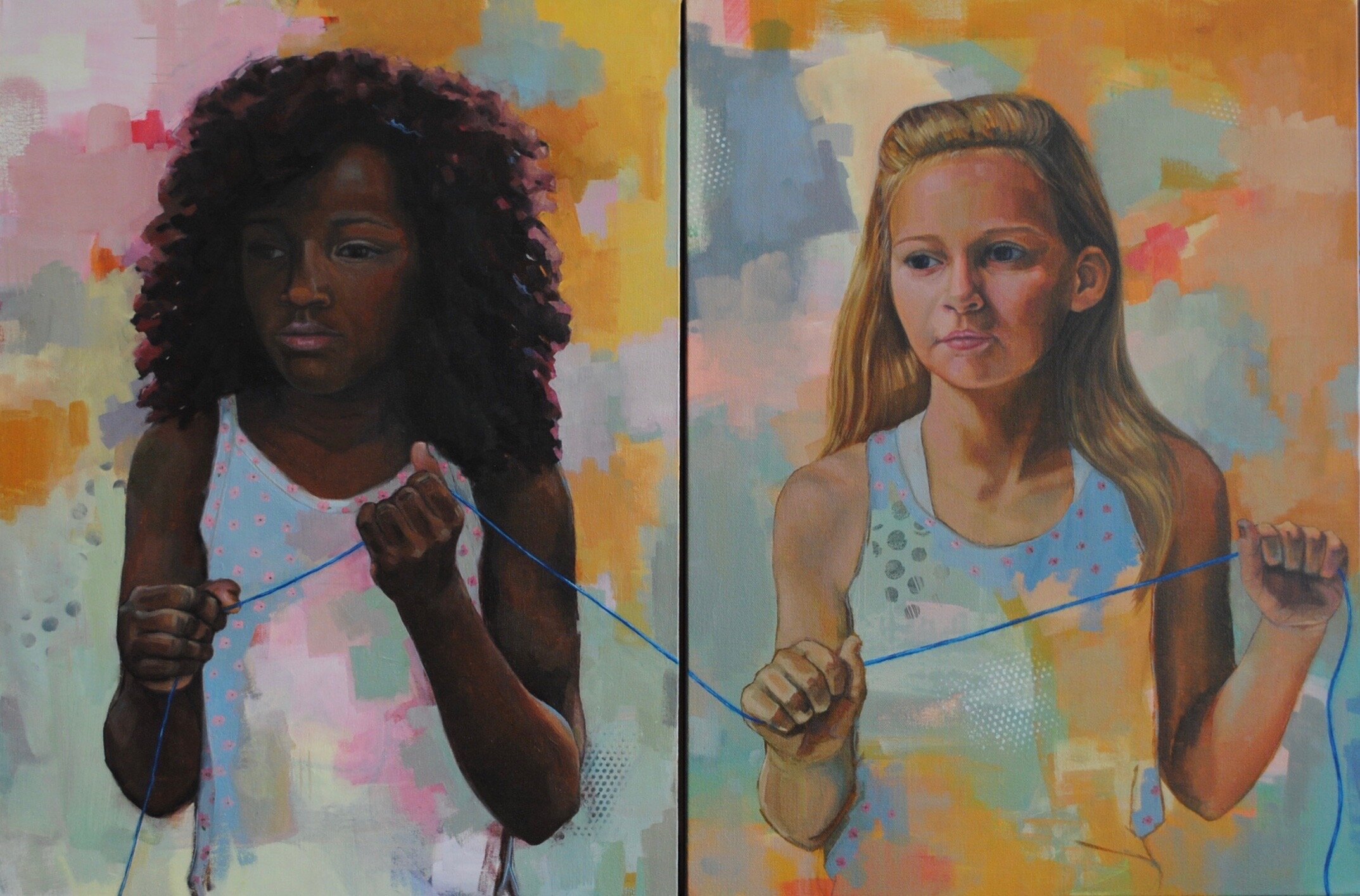
AAS: Laura, are you originally from the Little Rock area?
LR: I am from Little Rock and have lived here most, though not all, of my life. For five years of early childhood, we moved around the country frequently when my dad was in the Navy. Later, as the only Arkansan at my college in Florida, I got to experience being around lots of people from all over the world which was also formative.
AAS: After you graduated from Rollins College you went to work in marketing but eventually earned your Master of Arts degree from UALR. Why did you decide to study art?
LR: When I was a young girl, I took art classes with two local artists, Cindy Feltus and her sister Laurie Hickman. Later, I took classes with BJ Moses at the Arkansas Arts Center. Those women were some of the most fun and funny adults I’d ever met, so I knew there must be something pretty great about being an artist. In the 4th grade, I was impressed by a poet, Ted Parkhurst, who visited our school, Stephens Elementary. He dedicated so much time to each student and his lessons taught me the power and importance of the words we use.
I wanted to study art in college and attend grad school to study art, but I think I lacked confidence. Even though I worked in other fields such as marketing and advertising, I continued making art and couldn’t seem to stop. Finally, I had to admit to myself that being an artist was indeed my path, that the work was mediocre, and if I was going to spend the quickly passing years making art, I might as well improve in a critical environment like grad school. That’s when I applied to the University of Arkansas at Little Rock. I appreciated every minute of that program. I think part of the reason I thrived there is because I waited many years to return which made me more eager to learn and more grateful that I would have been had I attended grad school in my 20s.
AAS: You are a wonderful supporter of UALR and in this month’s Inviting Arkansas article you talk about their Holiday Wish List Campaign. Why do you feel giving back is so important?
LR: Thank you! Well, there are few answers to this one. I can’t be a big donor but I can be a loud cheerleader as a way of being grateful for my experience at UA Little Rock. When thinking back on each class, I can say every single professor I had was excellent. That’s pretty amazing and had a huge impact on how much I learned. I can’t say enough good things about the Department of Art & Design in particular.
Apart from my personal experience, I hope Little Rock residents are aware of what a gift it is to have a university in our city. We need to be clamoring to help the school be the best it can be because cities with universities have more good stuff: sports, entertainment, diversity, an educated population…this is not my area of expertise so someone else could really sell the benefits. But I know that putting our resources in education pays off for the community.
As far as giving back in general, artists do not always have the deepest pockets for financial giving, but the artists I know are an extremely passionate and generous bunch. Giving back can come in many forms: financial, time, expertise, and simply being vocal about our passions, like the Inviting Arkansas issue you mentioned. Using social media, it is easier than ever to make supportive comments about social causes and help spread the word about all the incredible things people are doing. This lifts up each other and also balances some of the negative news that is out there.
Herman Maxwell Higgs, Expert Fisherman and Storyteller, 9” x 12”, oil on canvas
AAS: You have done some terrific portraits and I especially like Herman Maxwell Higgs, Expert Fisherman and Storyteller. You really captured in his eyes and face his love of telling ‘fish stories’, I bet.
LR: Your comment makes me really happy because it lets me know that I succeeded in something important: communicating an essential truth about a person. Artists I admire - Velazquez, Goya, Alice Neel - can do this and it gives me a thrill to see their work because something magical happens, like a deep truth is passed from the sitter, to the artist, to the viewer, connecting all three with a thread that knows no bounds or limits of time.
AAS: You do a lot of hands-on teaching, workshops and lecturing. You must be a real people person.
“Teaching is the greatest gift. It is a selfish act, really.”
LR: Ha, I am a people person…some of the time. Being an artist is very solitary, especially during Covid. Admittedly, this suits me well because being alone in the studio is a constant yearning. I think I am one of those introverted extroverts - or extroverted introverts.
Even though I thrive with lots of alone time in the studio, I do also gain so much by teaching and lecturing. I’m a nervous wreck before a lecture and if I dare watch myself on video I absolutely cringe. My hands and face are WAY too dramatic. I’m working on calming down when giving lectures but…it is all so exciting and some hand gestures just can’t be suppressed!
Teaching is the greatest gift. It is a selfish act, really. One reason I love it so much is because I learn from each and every student. Another reason is because when people sign up for an art class, they are letting themselves be vulnerable. And I see the pressure and criticism each student puts on themselves. We all have that in common and it can be such a relief to acknowledge it, and learn how to enjoy art making without putting pressure on ourselves or the outcome.
Also, it recently dawned on me that almost every lesson during a workshop can be some sort of deeper metaphor for life. For example, often we work on art and it does not turn out the way we planned or envisioned. Our first reaction might be utter disappointment or a feeling of failure. But what if in our misery, we fail to see something beautiful happened? Just because it wasn’t our plan, doesn’t mean it is bad. It just means it is different than expected. And once you learn lessons like this, art making can become extraordinarily uplifting. I appreciate bonding with artists over stuff like this which makes me feel like I might be an extrovert after all.
I’m working on the spring workshop schedule now and the best way for people to get information about workshops (and exhibits, lectures, etc.) is to sign up for my monthly newsletter.
AAS: Recently you have been creating a series of paintings of people looking at art in museums. Talk about what inspired you to start that series?
A Quiet Spot, 12” x 16”, oil on wood panel
LR: I’ve been collecting photos and sketching people in museums for about seven years and finally developed a group of 32 paintings in the last year for an upcoming exhibit. I am really excited about the “Museum Meditation” paintings for many reasons. On a technical level, the paintings are created with brushwork I’ve been trying to learn for years and am finally achieving. And the group is very tight, very cohesive. If you like the paintings at all, I think it will be enjoyable to look closely and start to figure out which ones you enjoy the most and why. There are lots of little connections and tricks in the paintings as a result of watching people in museums for many years with an open mind, really looking at how people relate to art and noticing small but magical moments. Sometimes, the people match the art. Sometimes, it seems like we can see a relationship developing between the art and the person looking at the art.
Another strange aspect of these paintings is the realization that art in museums is a copy of something in life, whether it is an abstract concept or representation of something in our world. I am copying a copy by including museum art in my paintings and then, to go further down the rabbit hole, a viewer of my paintings is doing what the figure in my paintings is doing…looking at art. A duplicate action is created that I find fascinating. It makes me wonder, why do people make art? What does looking at art do for us as humans? It must do something because artists have been at it for thousands of years and art museums have existed for over 500 years!
The art I most admire can present a simple seeming scene or subject that can be enjoyed on a purely aesthetic level, but then can allow the viewer to take a deep dive into complex thoughts and questions. I’ve been hacking away for years trying to achieve this type of work and believe the museums paintings get me closer. I am really excited to get to show these paintings at Justus Fine Art Gallery for the month of February. There will be an actual opening on Friday, February 5th as part of the Hot Springs Gallery Walk and the owner, Dolores Justus, and I are brainstorming ways to allow people to engage with the work (online viewing, a recorded lecture, a Zoom Q&A, Instagram Live interview, etc.) without leaving the comfort and safety of home.
Moment of Meditation, 12” x 12”, oil on wood panel
Becoming Rothko, 12” x 12”, oil on panel
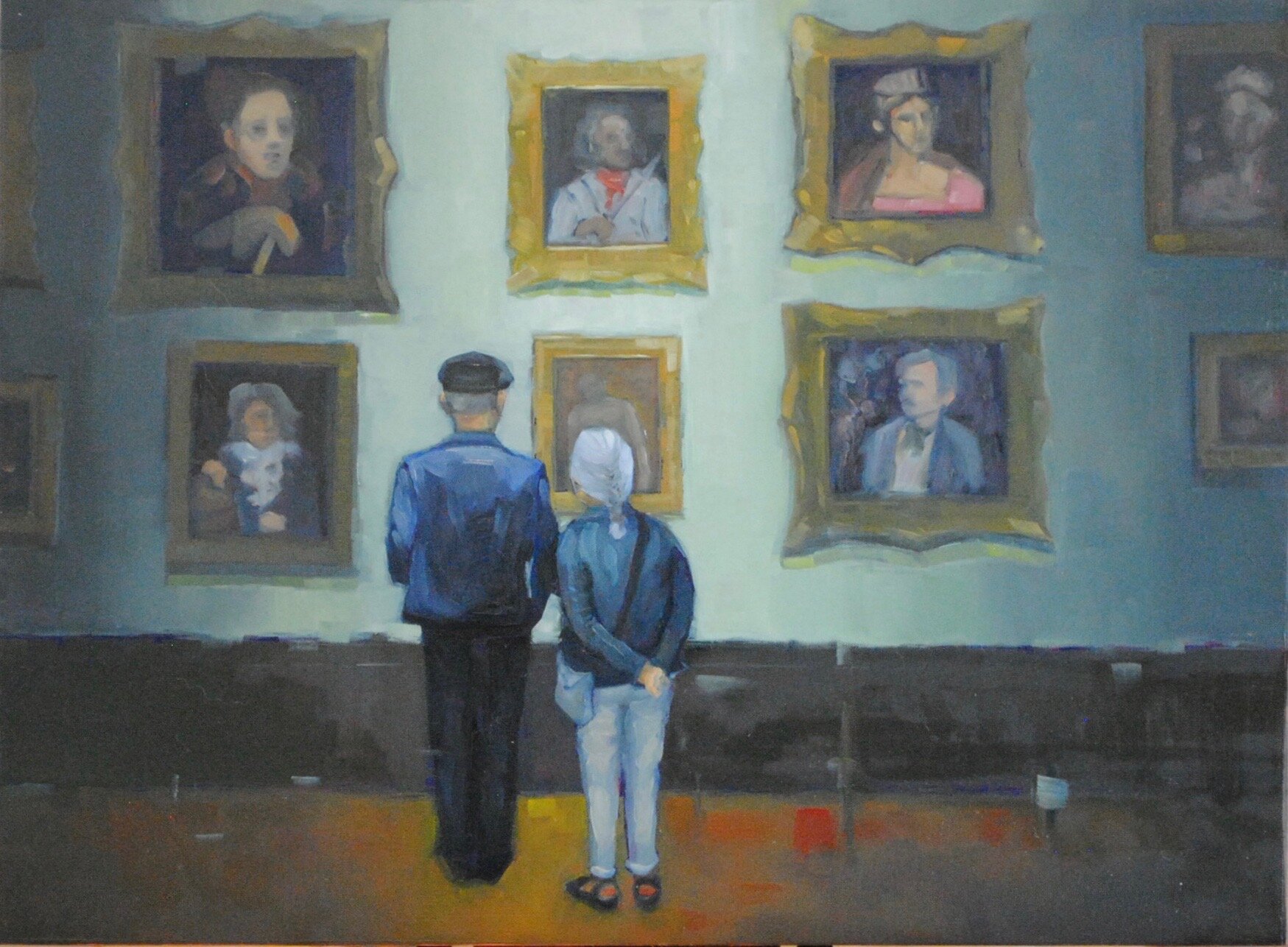
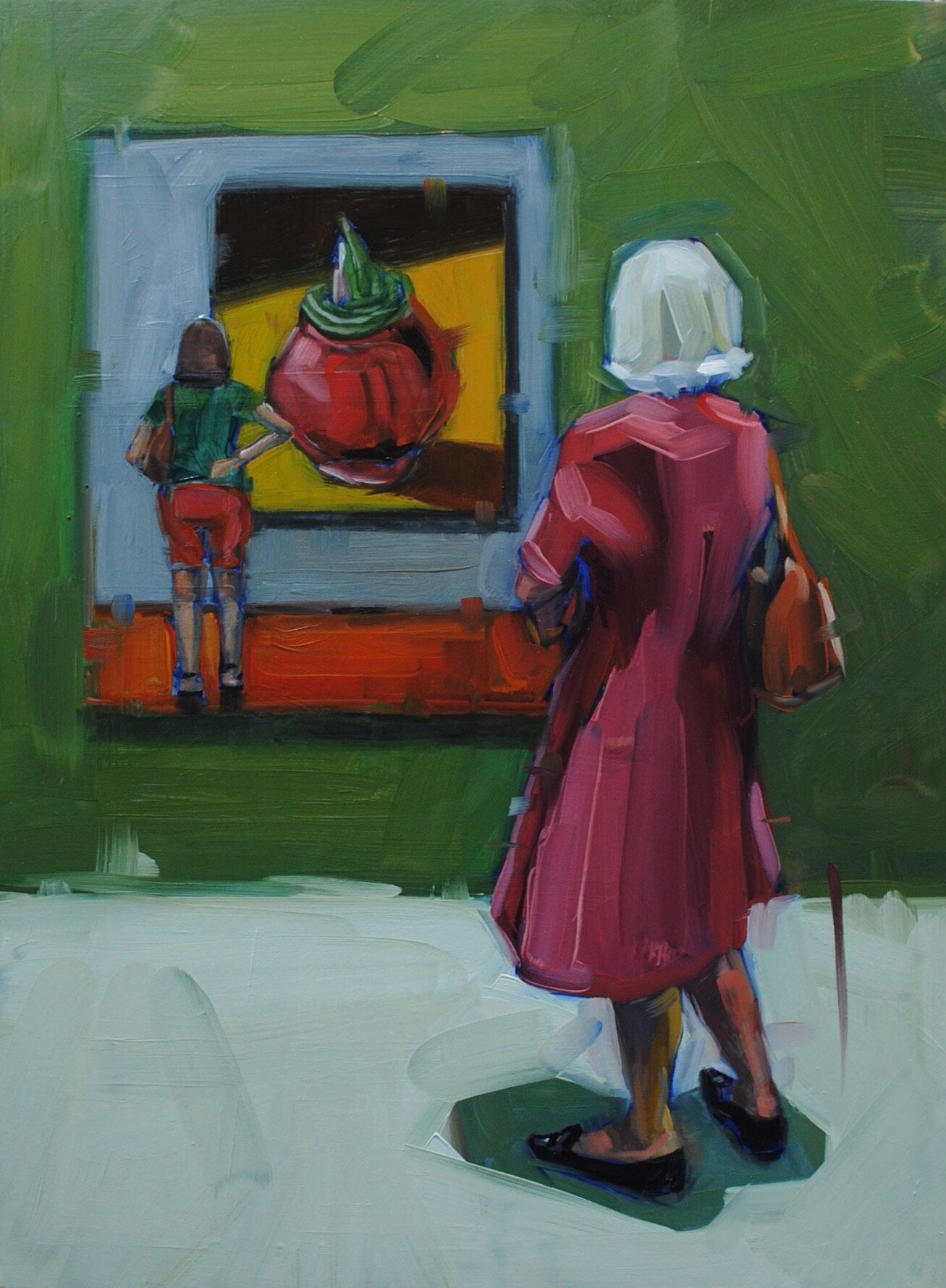
Reflecting, 20” x 16”, oil on wood panel
AAS: You say that great works of art communicate with the viewer if they stop and listen. I think that is so true – and sometimes the experience of viewing in person can be especially powerful. You have captured that, I think wonderfully, in Reflecting and in Inspiration, which I think is a very clever piece. Would you talk about those?
Inspiration, 9” x 12”, oil on wood panel
LR: Thank you for noticing there is a bit more going on in those pieces than what is initially apparent. I hesitate to over-explain because I want people to bring their own experience, history and interpretation to the work. But I can say, the work touches how visual imagery in the modern world impacts how we value and define ourselves and how we perceive each other. The mother in Reflecting is holding hands with her children in the same way I held hands with my children. They stand in front of a painting that is so oversized, it demands to be seen. Until recently, it was uncommon to see a variety of people represented in museum exhibits but here, this mother can see herself being honored and worth consideration.
The painting Inspiration is based on a provocative and startling Kara Walker exhibit. In the Broad Museum, I noticed a woman reading the statement about the exhibit. Her fitted black outfit made her look like a silhouette. I’m not implying she is a Kara Walker character, but the scene prompted the realization that Walker’s art can wedge its way into our minds, so we see things differently than we did before seeing her work. This allowed me to consider how art in museums shows us something tremendously important: a perspective beyond our own. When someone else’s view is presented through art, we can let our guard down and really listen.
“Sometimes, it seems like we can see a relationship developing between the art and the person looking at the art.”
AAS: You have been working on a provocative series of mixed media perspectives on this crazy 2020 - pandemic and other events. Would you talk about this series?
LR: I actually started working on these pieces four or five years ago before the 2016 presidential campaign. I was using mixed media materials (collage, image transfer, stencils, drawing, painting) to sort through my own thoughts and responses to language being used by politicians. Our entire reality is built on words and I saw a fissure in reality - people believing two high contrast versions of events. One belief seemed to be developed using a warping of language. Therefore, much of my work is text based. The motivation behind the work has ebbed and flowed. At times, it is like a personal journal and other times the work is more thoughtfully developed considering the possibility of exhibition.
While I remember being utterly stunned at that time. My close examination of political language and action in 2016 through 2019 did not prepare me for the events of 2020. Unfortunately, there are too many topics to tackle now, though I am compelled to keep trying. Often, I get drained from doing this type of work and quit for a while. But inevitably, the ideas start to bubble to the surface and I find myself back on the mixed media table, sorting through materials and ideas.
AAS: I especially love The World is Waiting. How did you conceive the imagery in that work? That tune has quite a history. And of course, there is Dr. Fauci’s A Hero.
The World is Waiting, 15” x 12”, mixed media on paper
LR: The World is Waiting is an example of how art materials can guide us to better understand our complicated thoughts. Varied opinions such as doubt about Dr. Fauci completely perplex me. Often, I think one huge question we Americans miss in deciding what information to believe, is asking ‘what does the speaker gain by me believing this message?’ There are people making millions by promoting invalid, dishonest, and fear-based information. So all this was on my mind as I was working with a stack of collage materials, listening to Dr. Fauci speak, without bias, without political or economic gain, and without using propaganda, and the parts just came together in that collage. The inclusion of the sheet music is completely serendipitous and shows how materials can guide the direction of the artwork. I'm so grateful for a student who gave the sheet music to me during my last in-person workshop because the song is perfectly fitting, on so many levels, of our current times.
A Hero is a piece that follows the timeless tradition of honoring someone with a portrait. It also uses layers of collage and Dr. Fauci is seen as a bright light in a dark environment. I hope the painting presents him is a beacon of hope and truth. Those who serve the public based on their training and a desire to help others are our heroes and making art honoring our heroes is my small way of having a voice, showing respect, and giving thanks.
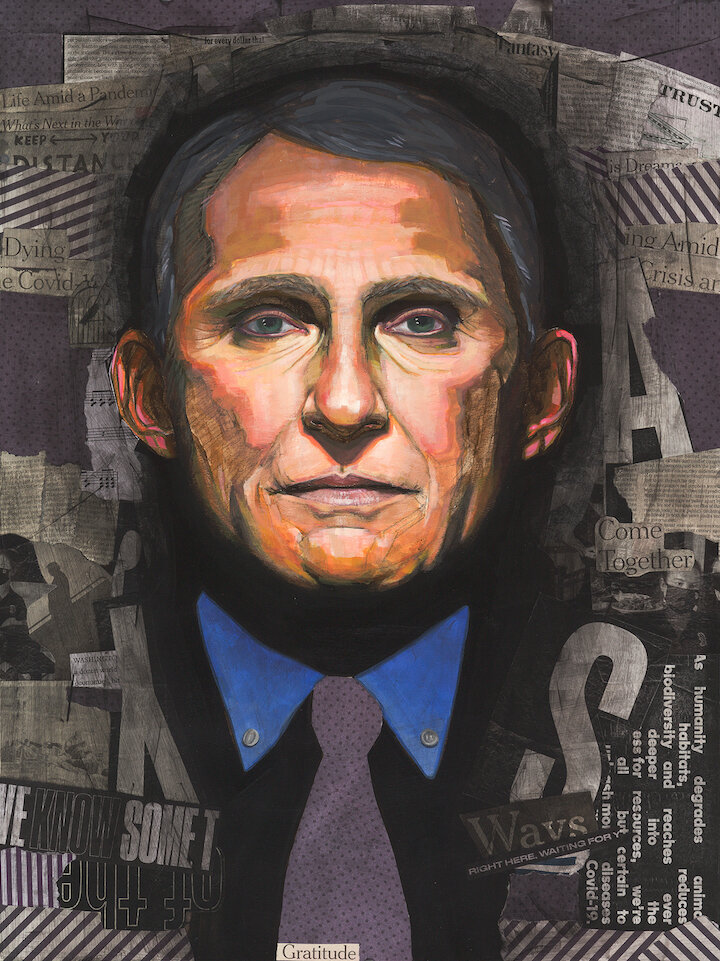
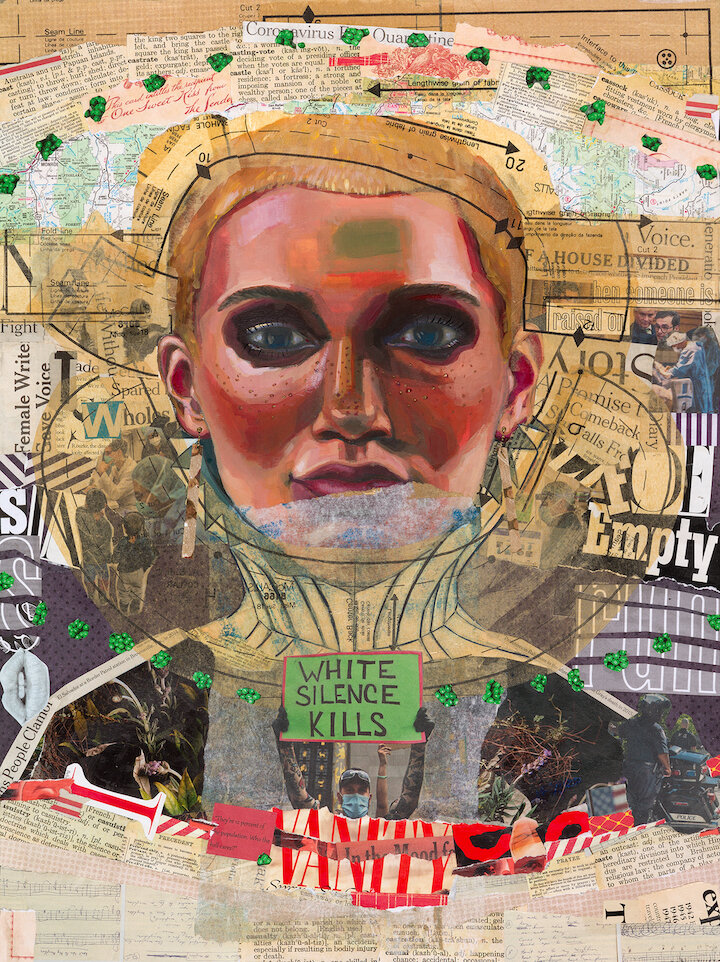
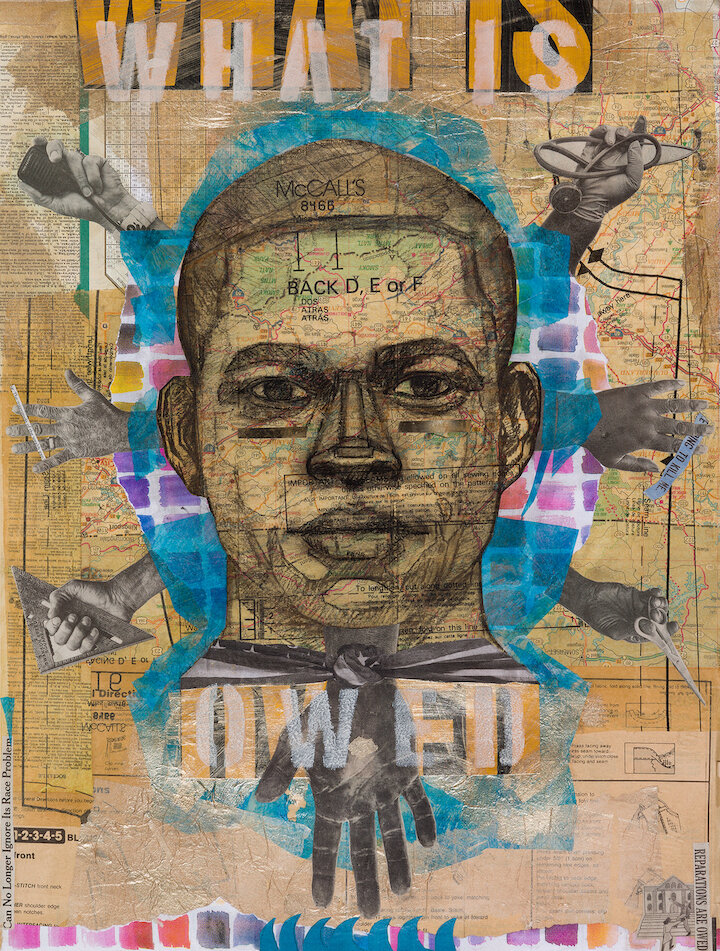
AAS: You are in many shows and juried exhibitions every year, except 2020 of course. Has it been difficult for you personally to be physically isolated from other artists, students and the public? Or has 2020 been a chance to recharge?
LR: After almost a year of staying home, making lots of art, tackling big admin tasks (like the website and the newsletter), I am itching to participate in art events but want to do so safely. I'm especially thankful to have two upcoming exhibits - the previously mentioned one at Justus Fine Art Gallery in February - and a group show at Cantrell Gallery in Little Rock on January 15th.
Overall, it has felt like a huge break pedal was pushed down which has pros and cons. It forced me to more deeply consider what I want to paint and why, without having constant deadlines. So the cancellation of many opportunities is both a disappointment and a gift. I am almost embarrassed to admit how much I love having more studio time. I am totally content for long hours all day and night in there. But, as we touched on earlier, I am not a true introvert. I really miss people. I especially miss hugging people. Now that my children are getting older, I am able to spend more time with friends and artists and I look forward to resuming time together again. Plus, most of my work is figurative, so I can’t hole up in the studio forever! I do need to see and engage with people in order to develop ideas and materials for my paintings.


